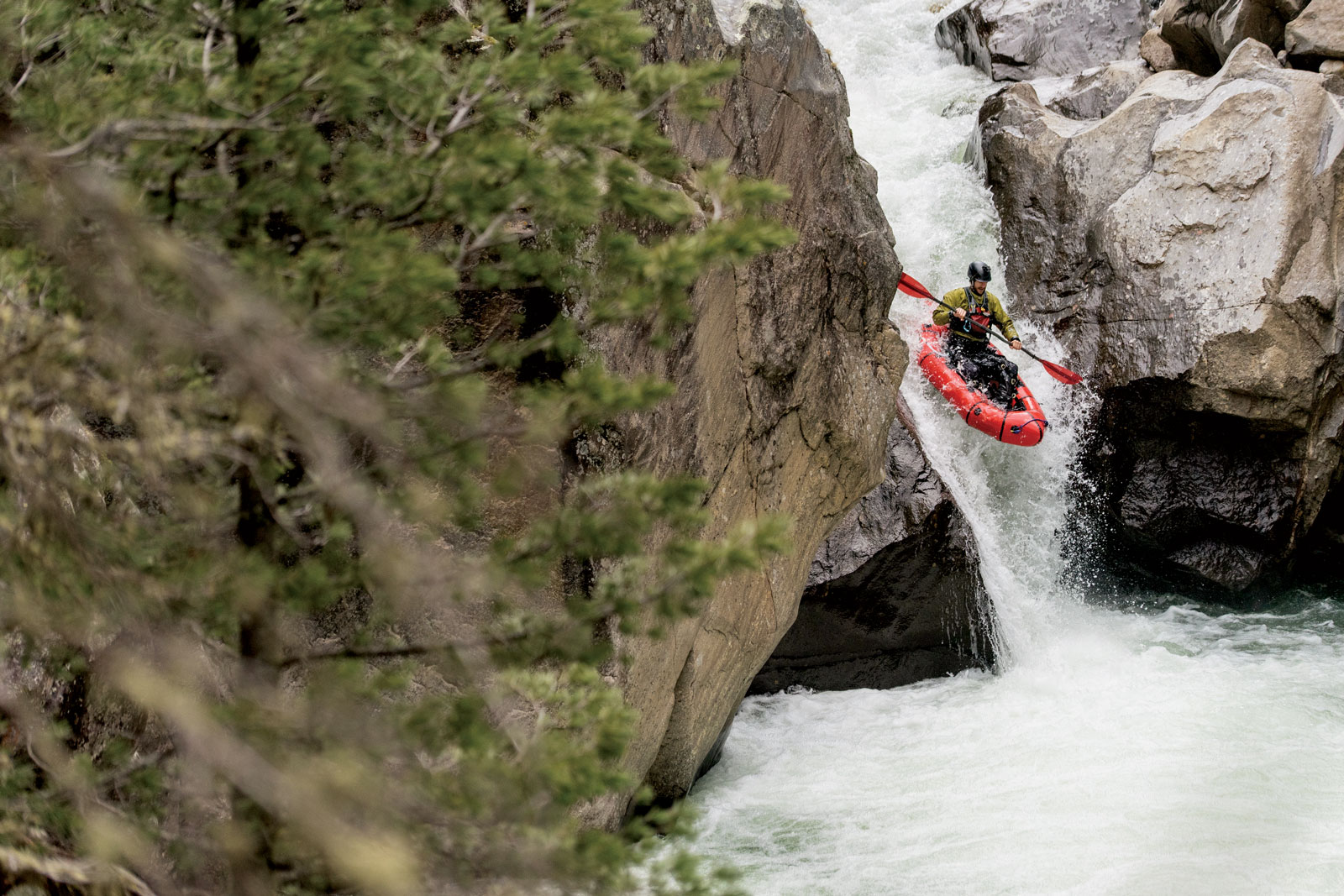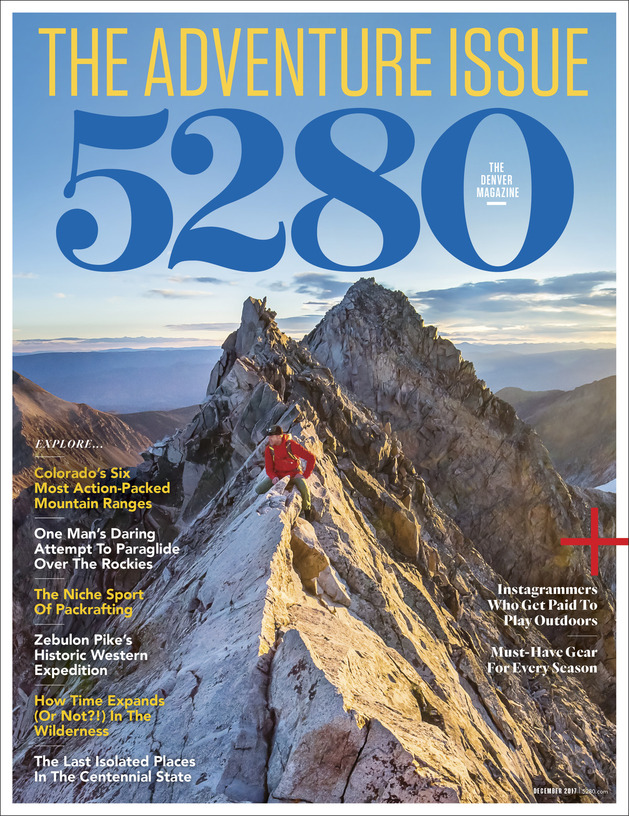The Local newsletter is your free, daily guide to life in Colorado. For locals, by locals.
In 2000, Thor Tingey, a scruffy-bearded Colorado College student, was preparing for a summer expedition across Alaska’s Brooks Range when a package arrived for him at his mother’s house in Anchorage. Sheri Tingey opened the box up, took one look at the tiny nylon raft inside, and was thoroughly unimpressed. The boat, custom-made by a Seattle-based former Boeing engineer, was lightweight and designed for flat water—hardly suitable for crossing 600 miles of rugged Alaskan wilderness and Arctic rivers.
“I thought, You are toast,” Sheri says. “You’re bringing this across the Brooks Range? I don’t think so.” At the time, there were no boats on the market light enough to carry long distances and durable and nimble enough to descend white water. As luck would have it, Sheri was a white-water kayaker with a background in design; she’d owned a custom ski-clothing shop in Jackson, Wyoming, in the 1970s. She hastily glued some fabric on the floor of Thor’s boat to reinforce it for the journey ahead.
More than a month later, Thor returned from his trip. The boat got him across a series of rough rivers, but he saw tremendous room for improvement. He also identified refinements that could be made to the Walmart-bought Sevylor trail boats his four buddies had used. He showed the battered, waterlogged, moldy crafts to Sheri. “He said, ‘Mom, build me a boat,’ ” Sheri recalls. “It was one of those things where you don’t know what you’re getting into.”
Within six months, Sheri had built a prototype for her son, and a year later, she started selling handmade packrafts to Alaska’s adventurous set. The one-person inflatable boats weighed less than five pounds, rolled up small—to about the size of a campfire log—and could deftly navigate white water. They could also be inflated on the fly with the help of a large nylon bag that came with the vessel. (The bag’s nozzle fit onto the boat’s valve; the boater could fill the bag up with air, seal the top by twisting it, then push the air into the craft.) The boats started to gain a cult following, and in 2007, Sheri moved her company, Alpacka Raft, to Mancos so that she could more easily receive supplies, ship boats to customers, and be closer to her mother, who lived in Phoenix.

Over the years, Alpacka Raft developed features such as a spray deck to keep paddlers dry and a longer stern to prevent them from catapulting backward in big waves. Zippers in the boat’s inflatable tubes allowed rafters to store gear inside instead of on top, increasing stability. As the vessels became drier, safer, and more maneuverable, more people started using them and imagining new possibilities for what the rafts could do.
“These boats change the way you look at maps,” says Mike Curiak, a Grand Junction–based bicycle-wheel builder, pro mountain biker, and packrafter. “Those blue spaces and lines that denote waterways used to be stumbling blocks. With packrafts, they’re now travel routes. It’s a whole different way of looking at the world.”
In the past five years, packrafting has surged in popularity in parts of the United States. Alpacka, the industry’s largest manufacturer, now sells about 2,000 boats annually and other brands, such as Aire, Supai Adventure Gear, and Kokopelli Packraft, have started producing models. Enthusiasts are clustered in Alaska and the Rocky Mountains, and the sport is gaining footholds in the Pacific Northwest and on the East Coast, according to a recent survey by the American Packrafting Association (APA). In 2011, the National Outdoor Leadership School incorporated the vessels into its courses, and commercial outfitters in Moab, Utah, the Grand Canyon in Arizona, and Alaska now offer guided packrafting trips.
Portable boats are not a particularly new or novel idea. Athabascans in Alaska have carried boats made of hides across great distances for centuries, assembling them on the shores of waterways with birch branches. In the 1840s, a lieutenant in Britain’s Royal Navy invented a portable, inflatable rubber boat for traveling the tundra and waters of the Arctic, but it never became a commercial success. The ancestors of modern packrafts were born during World War II, when the U.S. military supplied planes with tiny rafts in case pilots survived crashes into the ocean. Adventurers began purchasing these crafts at army surplus stores as early as the 1950s and took them into the wilds.

In the 1980s, a small group of hardy Alaskans started using boats made by a Minnesota-based company named Sherpa to cross rivers during overland expeditions. Because the vessels opened up the possibility of traveling routes riddled with rivers and lakes that were too cold or too big to swim, the paddlers apparently weren’t bothered by the fact that the boats were essentially glorified blow-up kiddie pools designed for flat-water fishing. After splashing through a run of Class III rapids, they would be shivering, belly-deep in glacial meltwater. Still, even after Sherpa discontinued production, Alaskans kept patching and re-patching the remaining models.
“The kayakers would ridicule us for trying these boats,” says Roman Dial, one of the sport’s pioneers and the author of Packrafting! An Introduction and How-To Guide. “Now, I’d say 90 percent of the things you can do in a kayak, you can do in a packraft.”
As Alpacka pioneered higher-performance boats, customers began taking them on more demanding rivers and white-water test pieces, such as the Colorado, Animas, and Arkansas rivers. Today, some intrepid boaters are also exploring hairy backcountry creek runs that require considerable hikes, such as the Class III and IV section above Vallecito Creek, a legendary white-water stretch in southwest Colorado. The rafts’ maneuverability has also attracted beginners and weekend warriors interested in floating classic multiday trips on the Chama, San Juan, and Yampa rivers and remote low-water desert streams like Utah’s Escalante and Dirty Devil rivers.
“We call them the season-extenders,” says Steve “Doom” Fassbinder, a Colorado-based sponsored mountain biker and packrafter who also works for Alpacka. “You can go out and run rivers in a packraft when kayakers and rafters don’t even see them as possible.” (Packrafts can navigate shallower rivers because they only require a few inches of clearance.) More creative uses include floating out hundreds of pounds of moose meat after a hunt and rigging up a sail to cruise across a wilderness lake.
“Originally the idea of packrafting was, I want to go from point A to point B, there’s water in my way, and a packraft allows me to navigate that water,” Thor Tingey says. “Now, the vast majority of packrafters out there look at the water first, and the land is the obstacle.”
As popularity grows, land managers are still figuring out how to oversee these new recreationists. “Packrafting lets you be more free-form [in how you travel],” says Joseph Bell, president of the APA. “That’s part of the delight, but it’s also part of the challenge of managing it.” Unlike rafters, he says, packrafters can put in and take out of a river at will, so impacts are dispersed.
Some areas, such as Denali National Park, have embraced the new mode of transportation. Others, such as Yellowstone National Park, still prohibit boaters entirely. A few protected areas have started to incorporate these recreationists into permitting systems: Canyonlands National Park, for example, requires packrafters to secure river permits if they’re floating more than two miles or camping in the river corridor. Eventually, Dial hopes that with greater numbers, packrafters will be able to advocate more effectively for access to sites.
For now, the sport is still considered niche. The APA has a mere 1,100 members; by comparison, the American Canoe Association boasts about 40,000. But that means there are still plenty of opportunities to find solitude in places that are difficult to access with any other craft—from the crystalline pools of an Arctic river to the steep creeks of the Rocky Mountains to the remote streams that trickle through the Southwest’s slender sandstone canyons.
“Packrafting has this intrinsic appeal, and I think we’ll continue to see a surge in popularity,” Bell says. “Being able to switch between land and water on the fly, there’s just this wonderful sense of personal freedom.”
In early 2016, after an eight-year stint as a lawyer in Portland, Oregon, Thor Tingey returned to Alpacka with his wife, Sarah, a former Nike program manager. The couple now oversees the company’s sales and operations, which allows Sheri to focus on design. In April, the company debuted two new models and unveiled an overhaul of five other models with nifty features, such as new one-way valves, D-rings for strapping on gear, and a new spray deck.
They also moved into a 12,000-square-foot building, where they now employ 25 locals full time. From Alpacka’s website, customers choose colors, features, and fabrics in models priced from $595 to $2,445. Each boat is built to order, which takes two to five days, and then ships to its buyer. And even though the sport only appeals to a small, dedicated bunch of adventurers, Thor wouldn’t have it any other way. “I never want someone to buy a packraft who doesn’t really want it,” Thor says. “They’re not meant to sit in closets.”
Kate Siber is a freelance writer based in Durango. Email her at letters@5280.com.









